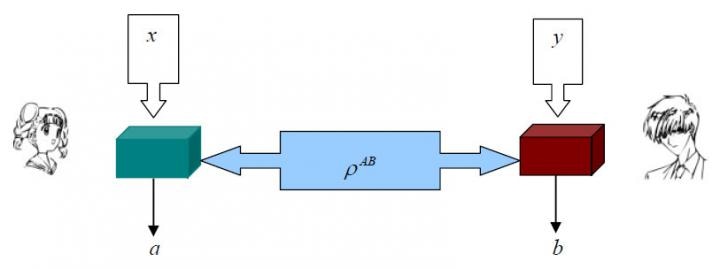Nov 14 2018
In quantum information theory, the link between subsystems of a composite quantum system is revealed by Bell nonlocality, EPR steering, quantum entanglement, and quantum discord, from various aspects, and they turn out to be the vital resources of quantum information technology.
 This is a sketch of a Bell experiment, in which ρAB denotes the shared state of Alice and Bob, x and y label their measurement choices, respectively, while a and b denote the respective outcomes. (Image credit: Science China Press)
This is a sketch of a Bell experiment, in which ρAB denotes the shared state of Alice and Bob, x and y label their measurement choices, respectively, while a and b denote the respective outcomes. (Image credit: Science China Press)
The connection between them is “the former implies the latter.” However, the reverse is not valid.
Certain local quantum measurements reveal Bell nonlocality, and a local hidden variable (lhv) model is not enough to explain the statistics of the measured results. It would be possible to use this non-classical property of quantum mechanics to process quantum information independent of the setting.
The well-known EPR paradox, which is a bridge from Bell non-locality to quantum entanglement, gives rise to the EPR steering. This can be used to develop certain innovative communication protocols under unique conditions.
A recent study has unraveled the equivalent characterizations and mathematical connotations of these two quantum characteristics, referring to Sci. China-Phys. Mech. Astron., 2019, 62(3): 030311.
The paper titled “Characterizing Bell nonlocality and EPR steering” was published in Sci. China-Phys. Mech. Astron., 2019, 62(3) by Professors Cao Huaixin and Guo Zhihua, Shaanxi Normal University. The researchers used mathematical methods to offer the strict definitions of Bell nonlocality and EPR steering, and have unraveled the equivalent characterizations and mathematical connotations of these two quantum characteristics.
Their characterization theorems prove that the sets of all Bell locale states and of all EPR unsteerable states are compact convex sets, forming a basis for the definition of metric functions of Bell locality and EPR steering. Meanwhile, they have also established some conditions that are adequate to determine the quantum state to be EPR steerable. It is a notable fact that the acquired sufficient conditions generalize the results of Chen Jingling et al. [Sec. Rep. 3, 2143 (2013)] on the 2 × 2 system to arbitrary-dimensional bipartite system and enhance the result of [Phys. Rev. A 95, 042117 (2017)].
Following are the novel concepts of the researchers: first, the Bell locality and EPR unsteerability of two-body quantum states for “specific measurement assemblage” are defined; then, the Bell locality and EPR unsteerability are introduced. Subsequently, Bell nonlocality and EPR steerability are introduced through the negative form of the aforementioned ideas.
In this study, from a mathematical viewpoint, the methods and concepts of Bell nonlocality and EPR steering are well perceived, their mathematical definitions are provided, and then, some of their equivalent characterizations are established.
Apart from unraveling the nature of the problem, the mathematical abstractions of these physical concepts also deduce certain innovative physical phenomena. Therefore, it is of immense scientific importance and reference value to further explore these physical concepts.
The National Natural Science Foundation of China (Grant Nos. 11871318 and 11771009) funded this study.